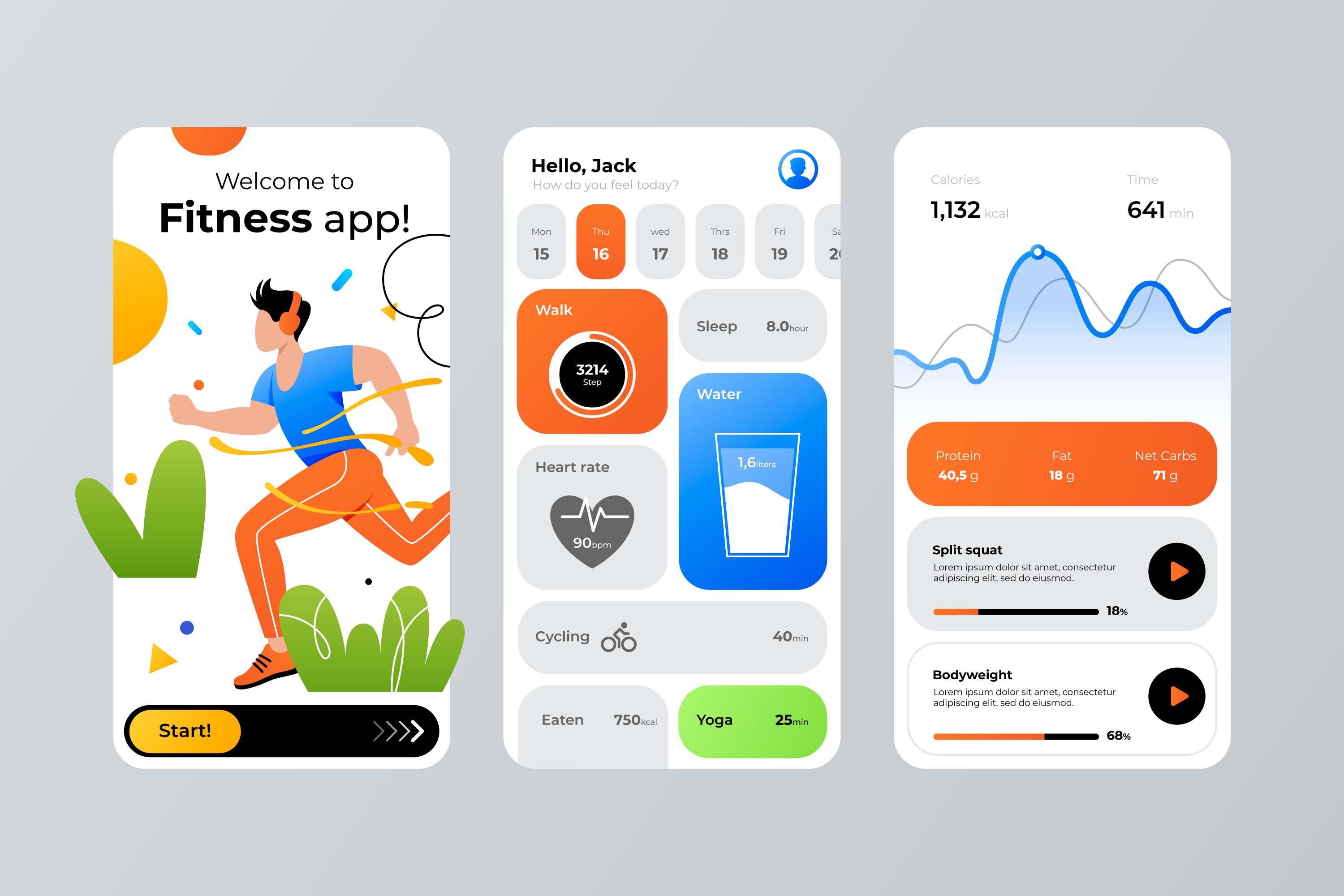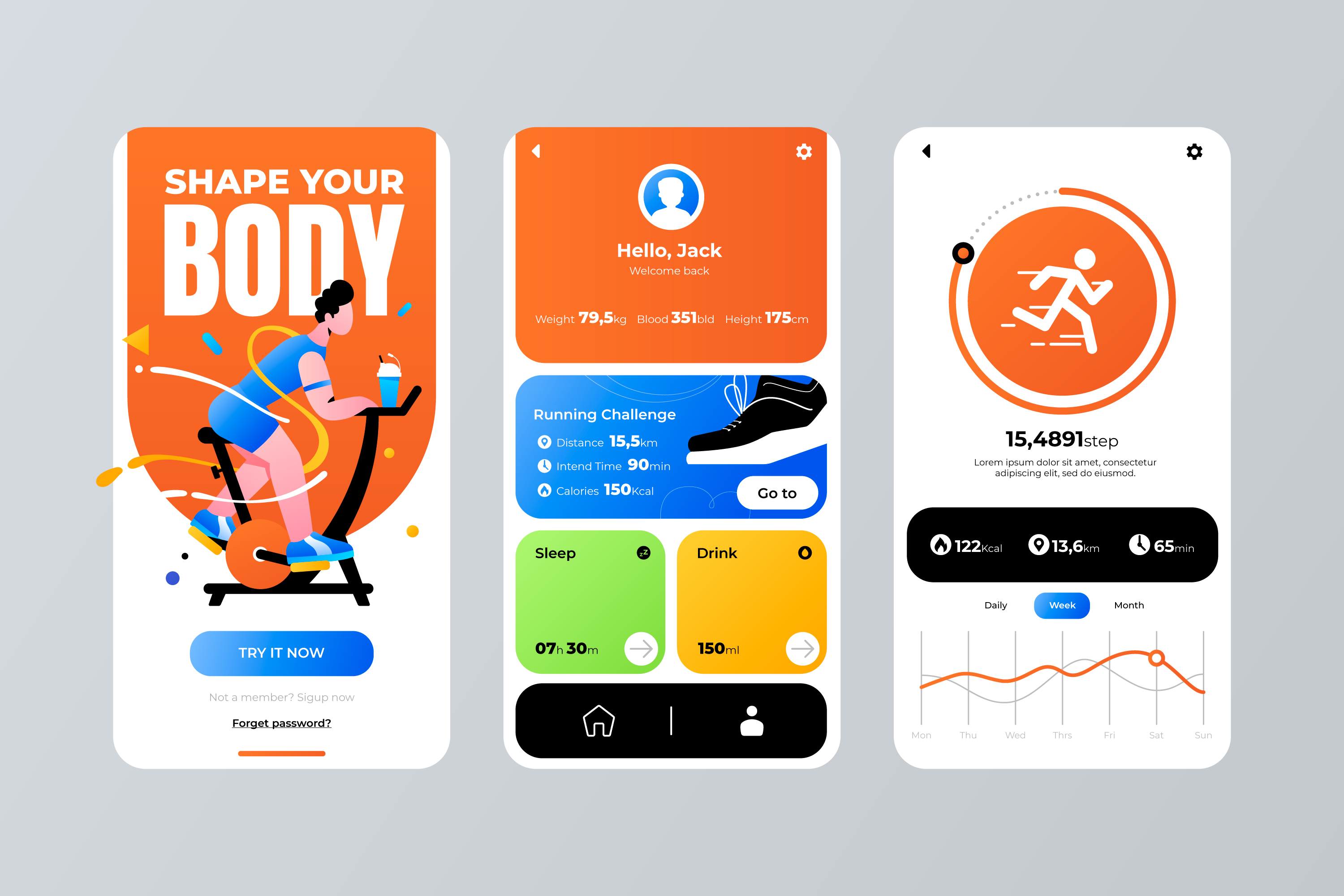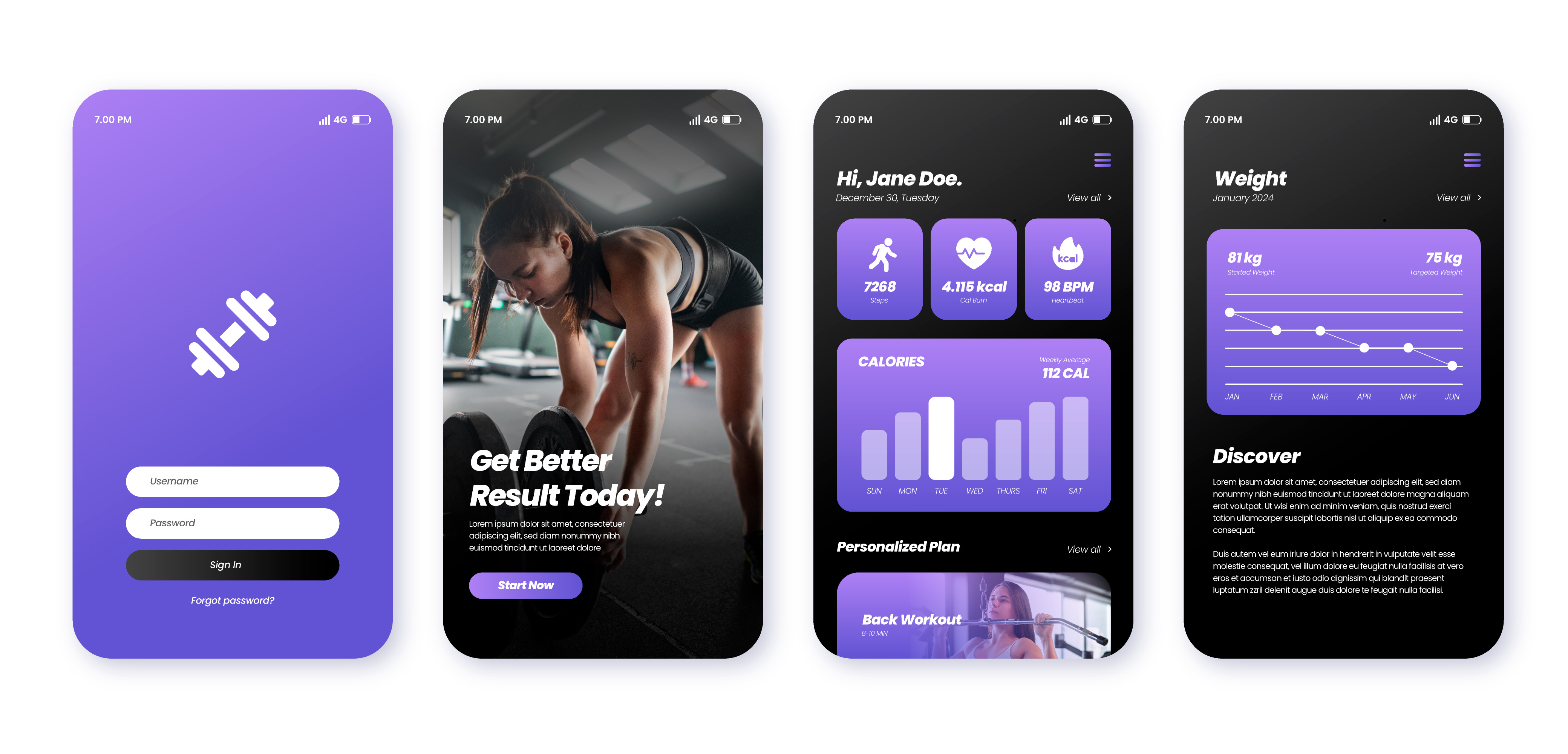A basic app might cost around $25,000–$60,000. If you want extra features like meal plans, trackers, or live workouts, the fitness app development cost can go up to $150,000 or more. In 2019, health and fitness apps made about $1.34 billion through in-app purchases. By 2024, that number had jumped to $3.88 billion, according to Statista. That’s nearly three times more in just five years. So, if you're wondering how much it costs to make a fitness app, the short answer is—it depends on what you want to build, but there’s clearly money in it.

What Impacts the Price of Building a Fitness App?
Thinking about launching your own fitness app? It’s a smart move, especially since the market keeps growing. In January 2025 alone, fitness and workout apps hit over 25 million downloads worldwide. That’s a clear sign people are still looking for digital ways to stay fit. Many are switching from gym memberships to app-based workouts because apps are easier to use and fit better into daily life. In 2024, fitness apps in the U.S. made nearly $1.8 million in revenue.
That kind of demand makes it a good time to enter the space, but what about the cost of developing a fitness application?
- Type of app you want to build. Simple fitness apps cost less. These apps may include login/signup, a list of exercises, workout timers, and progress tracking. But if you want live streaming, AI coaching, video libraries, or syncing with wearable devices, the cost goes up. More features = more time = higher price.
- Platforms: iOS, Android, or both. The mobile app development platform you choose matters. If you want to build for both iOS and Android, your developers need to write code for each or use a cross-platform framework. Native apps often give better performance but also cost more.
- Design and user experience. A clean and friendly app design helps people keep using it. But custom designs take longer to create. If your app includes animations, personalized dashboards, or unique icons, the price will go up. Good UX also means thinking through how people move between screens, and that takes time.
- Developer rates by location. Where your team is based affects the budget. Developers in the U.S., Canada, or Western Europe charge more per hour than those in Eastern Europe, India, or Southeast Asia. The quality can still be great, but rates vary a lot.
- Back-end and server costs. Apps with lots of user data, video content, or real-time updates need strong back-ends. You’ll also need cloud storage and hosting for content and user accounts. More storage and traffic mean higher server bills. That’s why apps with workout libraries or daily video content cost more.
- Features that change the price. Some features take more time and skill to build. Here are a few that push up the fitness app development cost:
- Live video sessions or classes
- Wearable integration (Apple Watch, Fitbit, etc.)
- Nutrition planning and meal tracking
- Chat or community forums
- Subscription payments and in-app purchases
- AI-powered recommendations
Each feature adds more work for developers, designers, and testers.
- Maintenance and updates. After launch, the work doesn’t stop. You’ll need to fix bugs, keep up with OS updates, and maybe add new features. That means ongoing costs. Maintenance is usually 15–25% of your original mobile app development budget per year.
The cost to develop a fitness application ranges from $25,000 to over $150,000. A basic version with a few core features might stay near the lower end. A high-end app like MyFitnessPal, Nike Training Club, or Fitbit’s platform can go well over six figures.

What’s the Better Way to Build a Fitness App: Do It Yourself or Hire an Agency?
If you want to make a fitness app, the first thing to decide is how to build it. You’ve got two main options. One: hire your own team and manage everything in-house. Two: work with a web application development services agency. Both paths can work. But they’re very different—especially in time, price, and results.
1. Project Control
Doing It Yourself: When you build your own team, you have full control over everything. You decide what’s being built and how. You can change your mind anytime. You can talk to the developers directly, adjust features, or tweak designs. But full control means full responsibility. You need to manage tasks, track progress, and fix problems. If something breaks, it’s on you.
Hiring an Agency: With an agency, you give them the idea and let them handle the work. They bring their own designers, developers, and testers. You don’t have to explain every little thing, and you don’t need to watch over them all day. Agencies know how to build apps from start to finish. They’re used to doing it. You still have control, but you don’t have to stress over every detail.
Winner: Agency. You still get the final say but without the daily stress.
2. Time and Speed
Doing It Yourself: Hiring and building your own team takes time. You have to find the right people, interview them, and hope they work well together. Then comes training, setup, and project planning.
If one person quits or gets sick, it slows everything down.
Hiring an Agency: Agencies already have a full team ready to go. They’ve worked together before. They follow a system. That means your app starts faster and is more likely to finish on time.
Winner: The agency moves quicker because the team is already in place.

3. Cost
Doing It Yourself: You might think this is cheaper, and sometimes it is. If you hire freelancers from low-cost countries and manage everything yourself, you can spend less.
But be careful. If the code is messy or the design doesn’t work, you’ll spend more time fixing it later. And hiring just one or two people means things move slowly.
Hiring an Agency: So, how much does it cost to create a fitness app with an agency? The range is wide. Based on our experience, a small app might cost $30,000–$60,000. A feature-rich app (like ones with AI, video libraries, or live classes) can go over $150,000. That’s a lot. But the cost comes with structure, speed, and experience.
Winner: DIY if you know what you’re doing. Agency if you want fewer mistakes.
4. Experience and Skill
Doing It Yourself: If you’ve built apps before, you may already know how to manage design, backend systems, and testing. But if this is your first time, expect a learning curve. Building a SaaS application takes more than just writing code. You need to think about security, payments, user experience, and updates.
Hiring an Agency: Agencies have seen all kinds of projects. They know what mistakes to avoid. They can plan better. They’ve tested different tools and platforms. They also know the little details that new developers often miss—like how long users stay on a screen or which colors work better on mobile.
Winner: The agency brings real experience and a smoother path to launch.
5. Ongoing Support
Doing It Yourself: Once the app is done, it still needs care. Bugs show up. Updates are needed. Platforms change. You’ll need someone to handle that. If you don’t have a team ready, the app might break or get outdated fast.
Hiring an Agency: Most agencies offer post-launch support. They can fix bugs, add features, or adjust things based on user feedback. You won’t need to search for new help each time a problem comes up.
Winner: Agency. They don’t vanish after launch. They stay with the project.
6. Design Quality
Doing It Yourself: Design matters. If the app looks odd or hard to use, people will delete it. If your team doesn’t include a real UI/UX designer, you might end up with clunky screens or confusing layouts.
Hiring an Agency: Agencies have proper designers who know how to build simple, good-looking apps. They think about colors, buttons, layout, and mobile use. They test things with real users. That makes a big difference.
Winner: The agency with a better design brings more downloads and better reviews.
7. Final Product and Future Growth
Doing It Yourself: If you only need to make a fitness app that is small—a personal tracker, or a basic workout list—you might be fine doing it yourself. But growing the app later may be tough. Your code might not scale well. You might need to rebuild parts of it.
Hiring an Agency: Agencies build with the future in mind. They often use frameworks and systems that allow easy growth. If your app grows to 1,000 or 10,000 users, it should still run well.
Winner: The agency offers a better choice if you want to grow your app over time.
So, What’s the Verdict?
If you’re building something basic and want full control, building on your own might work. But if you want to save time, avoid mistakes, and launch something people love to use, working with an agency is a safer bet.

How to Cut Costs When Building a Fitness App
If you’ve been thinking about building a fitness app, one big question probably comes up early: how much will this cost me? The cost of developing a fitness app can be anywhere from $25,000. It has a big range, and the final number depends on many things. But here’s the good news: you can still build a great app without spending more than you need.
Start Small with a Clear Idea
One of the best ways to save money is by knowing exactly what web app development is and what you want to build. Don’t jump in with a huge list of features. Start with the basics. What’s the main purpose of your app? Is it tracking workouts, counting calories, or giving users video classes?
If you start with a simple version—called an MVP (Minimum Viable Product)—you can test the idea and see what users like. Later, you can add more features. This helps you avoid wasting time and money on things people don’t want.
Pick the Right Team
Who you work with makes a huge difference in the cost of developing a fitness app. You can:
- Hire freelancers
- Build your own team
- Work with an agency
Freelancers are cheaper, but they often work on their own schedule and may not communicate well. Managing them can be tricky if you're not experienced. Building your own team gives you control, but it takes time and effort.

Test Often, Not Just at the End
One of the biggest mistakes in fitness app development is waiting too long to test. If you build everything and only then check for bugs or problems, fixing them will cost more.
Instead, test each part as it’s built. That way, you catch issues early. It's easier to fix one screen than an entire feature.
Avoid Building Too Much
Here are a few features people often build too early:
- Chat features
- Community boards
- Custom avatars or badges
- In-app video editing
- Full nutrition databases
These are nice to have, but they aren’t always needed right away. Instead, ask users what they want after they’ve used the app for a while. Focus on features that solve a real problem.
What You Should Not Try to Save On
Some parts of fitness app development are worth the cost. Here are three things you shouldn’t try to cut:
- Security – Your app might handle personal health info or payment details. If you skip security steps, you risk losing user trust or worse, dealing with legal trouble.
- Speed – Slow apps get deleted. Make sure your app loads fast and runs smoothly, even on older phones.
- Support and Maintenance – Once your app is live, people will report bugs or ask for updates. You’ll need someone to fix things, and it shouldn’t take weeks. Make a plan (and a budget) for updates.
The cost of developing a fitness app can feel overwhelming, but there are ways to keep it under control. Remember, you’re not just building an app—you’re building something people will use to improve their health. That’s a big deal. So take your time, plan smart, and build something you’re proud of.
The answers to your questions
What is the average cost to develop a fitness app?
It really depends on the features. A simple app with basic workouts and tracking can cost around $25,000–$60,000. If you want more stuff—like video, payments, or wearable support—it might go over $100,000. Bigger apps with full systems can pass $200,000 easily.
How much does it cost to maintain a fitness app?
After launch, you still have to fix bugs, update stuff, and sometimes add new features. Maintenance usually costs around 15–25% of what you paid to build the app. So if your app costs $80k to build, plan on $12k–$20k a year to keep it running.
Does adding AI and machine learning boost development costs for fitness applications?
Yes, a lot. AI features like personalized workout suggestions or real-time feedback are tricky to build. You’ll need more developers, testing, and time, so the final cost goes up fast.
Is making a fitness app profitable?
It can be. People spend billions on fitness apps each year. If your app solves a real problem and users stick with it, you can earn through subscriptions, ads, or in-app purchases. But you’ll need a good idea—and a better plan.
